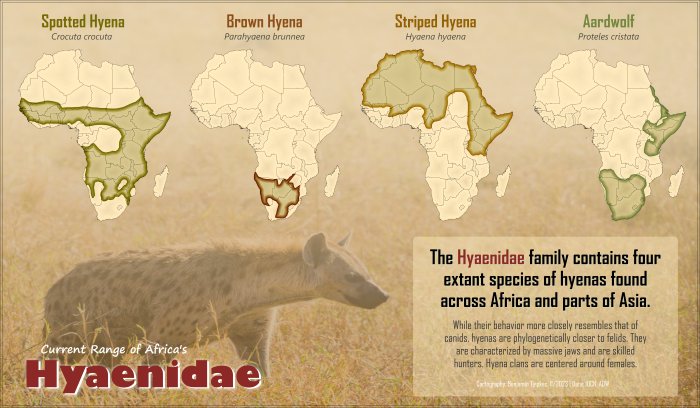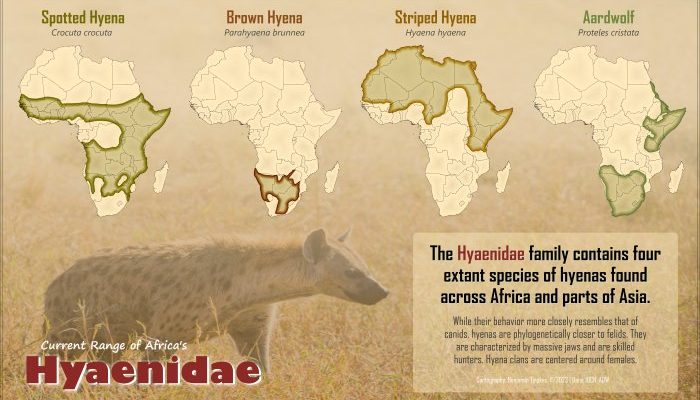
You might be wondering: where exactly do these unique animals call home? Well, it turns out brown hyenas have a very specific habitat that plays a crucial role in their survival. Let’s break it down, so you can better understand where these elusive creatures thrive and what their distribution looks like.
Understanding the Brown Hyena’s Habitat
Brown hyenas, with their shaggy brown fur and distinctive elongated bodies, are primarily *found in southern Africa*. Their preferred habitats include the dry savannas, *scrublands*, and semi-desert regions. However, just because they enjoy these areas doesn’t mean they’re stuck here.
These adaptable scavengers are equipped to handle various environments, which means they can sometimes be spotted in more arid landscapes, like the Kalahari Desert. Think of it as their way of playing the ultimate game of hide-and-seek, blending into these surroundings while hunting or scavenging for food. The sparse vegetation in these regions isn’t just a challenge—it also offers the brown hyena a chance to thrive.
When you picture their habitat, imagine wide-open spaces dotted with bushes and the occasional acacia tree. These natural features provide both shelter and a place to find food. With their keen sense of smell, brown hyenas can locate carrion from miles away, making this habitat perfect for their scavenging lifestyle.
The Geographic Distribution of Brown Hyenas
When looking at a map, you would find the brown hyena primarily concentrated in the southern parts of Africa, particularly in countries like Namibia, Botswana, and South Africa. Their distribution is quite specific and tends to avoid areas with heavy human activity.
Here’s the thing: while they prefer the desolate habitats, brown hyenas need enough space to roam freely. Their territory can range from 50 to 100 square kilometers, depending on the availability of food. This means they are always on the move, searching for their next meal and making their home in the vast emptiness of the landscape.
Interestingly, while their range is somewhat limited, brown hyenas are skilled at adapting to their environment. They can thrive in both rocky regions and sandy plains, which is a testament to their resilience. Imagine having the ability to adjust your living conditions based on what’s around you. That’s exactly what these remarkable creatures do!
Behavior and Adaptations to Their Environment
Brown hyenas are primarily nocturnal, which means they’re most active at night. This behavior helps them avoid the heat of the day and the watchful eyes of predators. During the day, they often find shelter in *rock crevices* or abandoned burrows, creating a cozy home away from home.
Their shaggy fur isn’t just for looks; it serves a purpose. The coarse hair helps them survive in the harsh climates of southern Africa, providing insulation against the cold desert nights. Plus, their long legs and agile bodies make it easier for them to navigate rocky terrain and sandy surfaces.
As scavengers, their diet consists mainly of carrion, but they’ll also munch on small mammals, birds, and even fruit when the opportunity arises. Their powerful jaws allow them to crush bones, making them proficient at taking advantage of what nature has already provided. You could say they have a “waste-not, want-not” attitude when it comes to survival.
Human Interaction and Impact on Brown Hyenas
The relationship between brown hyenas and humans can be a bit of a tricky one. While they tend to avoid populated areas, their habitats do overlap with farmland and human settlements. In some places, they’re seen as pests, leading to conflicts. Farmers might view them as threats to livestock, prompting a negative perception.
It’s essential to highlight that brown hyenas play a crucial role in their ecosystem as scavengers. By consuming carrion, they help prevent the spread of disease. *Here’s the thing*—by understanding this vital contribution, we can work towards fostering coexistence rather than conflict. Organizations and conservationists are working hard to protect these incredible animals, ensuring their habitats remain intact.
Educating local communities about the ecological benefits of brown hyenas can help lower tensions and promote conservation efforts. The more we learn about these unique creatures, the better we can appreciate their place in the ecosystem and our responsibility to protect it.
Conservation Status of Brown Hyenas
Brown hyenas are currently classified as *Near Threatened* by the International Union for Conservation of Nature (IUCN). While they aren’t on the verge of extinction, their populations are declining due to habitat loss and human-wildlife conflict. Protecting their habitats is vital for ensuring their survival.
Conservation efforts are underway, focusing on habitat preservation and reducing human-wildlife conflict. Protected areas in southern Africa, such as national parks and wildlife reserves, provide safe havens for these hyenas, allowing them to live and thrive without disruption.
However, the challenge lies in balancing conservation with the needs of local communities. Engaging residents in conservation initiatives is key. When people see the value of protecting brown hyenas and their habitats, they’re more likely to support conservation efforts.
The Future of Brown Hyenas and Their Habitats
As we look towards the future, the survival of brown hyenas hinges on our actions today. Protecting their habitat is essential, but it also requires a collaborative effort between conservationists, local communities, and government bodies. By creating a more sustainable environment, we can ensure that these remarkable creatures can roam freely in their natural habitat for generations to come.
In conclusion, brown hyenas are fascinating animals with unique adaptations that allow them to thrive in the wild. Their habitat ranges from dry savannas to semi-deserts, primarily in southern Africa. Understanding where they live and the challenges they face encourages us to take action in protecting them.
The next time you think about the diverse wildlife of Africa, remember the brown hyena. They may not always be in the spotlight, but they’re a vital part of the ecosystem. Let’s cherish and protect the places they call home, ensuring they continue to play their essential role in nature.

